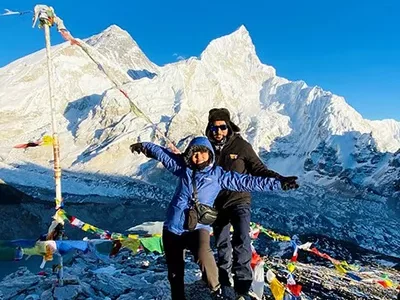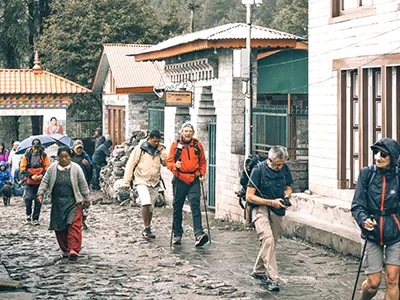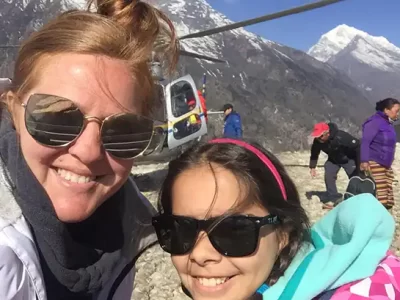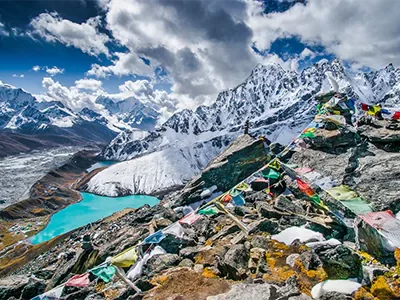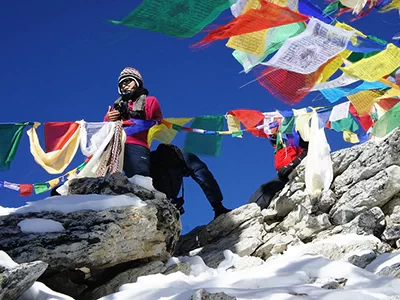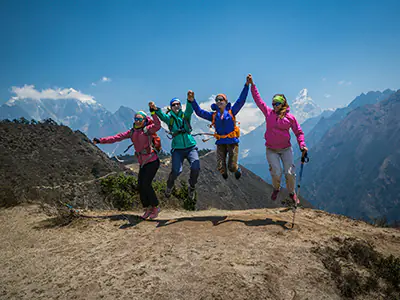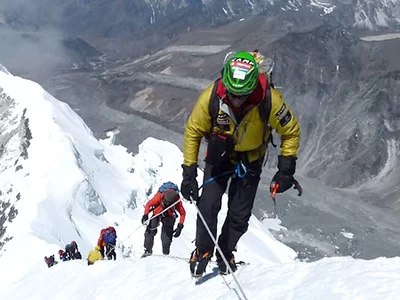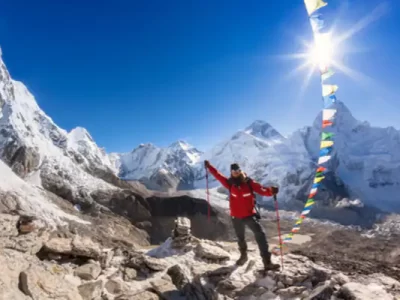Trekking in the Everest Region promises an unparalleled adventure that captures the hearts of trekkers and mountaineers worldwide. Nestled in the northeastern part of Nepal, this area hosts the world’s highest peak, Mount Everest, and unfolds a vast expanse of rugged terrain with dramatic landscapes and a rich cultural heritage. The trekking routes here challenge both body and spirit, turning every step into a stride toward personal and physical achievement.
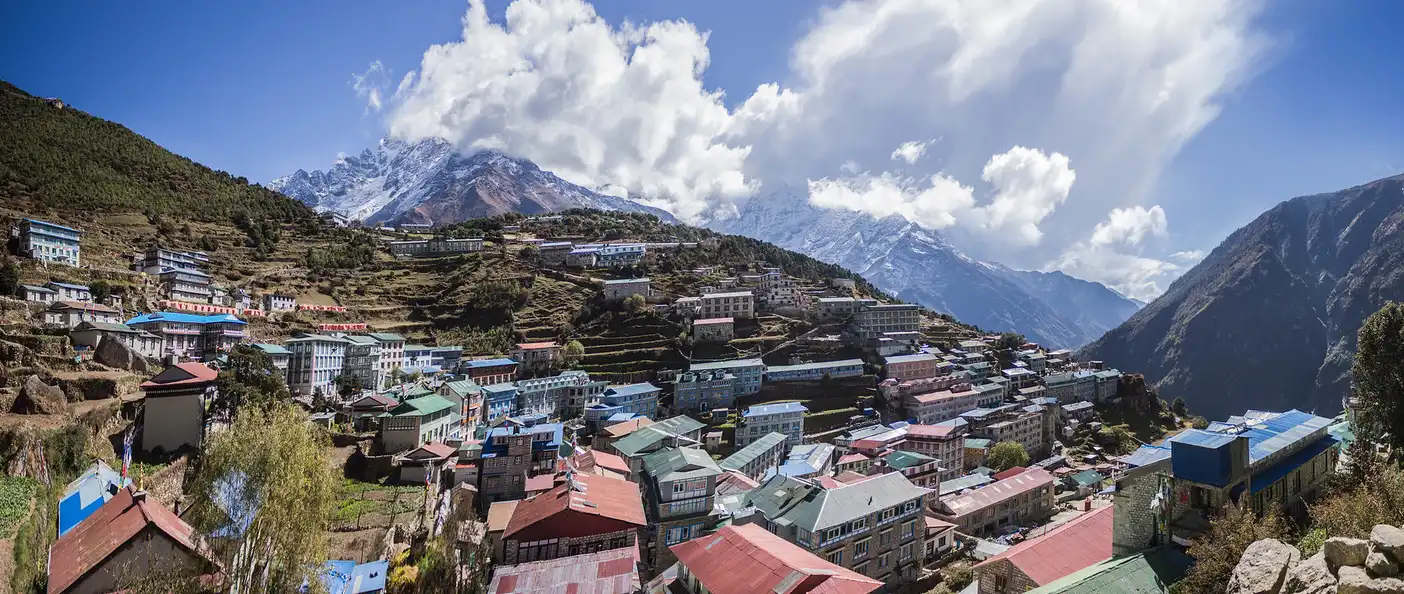
Known also as the Khumbu region, the Everest Region boasts majestic peaks such as Lhotse, Cho Oyu, and Ama Dablam alongside Everest itself. Famous climbers have historically walked the trails here, rich with mountaineering history.
The Khumbu Everest area captures the high-altitude trekking essence, offering breathtaking vistas and insights into the Sherpa people’s lives. Renowned for their mountaineering skills and deep-rooted Buddhist traditions, the Sherpas enrich trekkers’ experiences as they navigate this iconic Mount Everest region, where nature and culture blend in spectacular displays.
Everest Base Camp Trek
Luxury Everest Base Camp Trek
Everest Base Camp Trek with Helicopter Return
Reasons to Trek in the Everest Region
Trekking in the Everest Region extends beyond a physical challenge; it immerses trekkers deeply in the local Sherpa culture. Renowned for their climbing expertise and vibrant traditions, the Sherpas warmly welcome trekkers into their villages, monasteries, and homes. This cultural exchange enhances every trekker’s experience, offering a unique view of how people maintain a harmonious balance with the harsh natural surroundings.
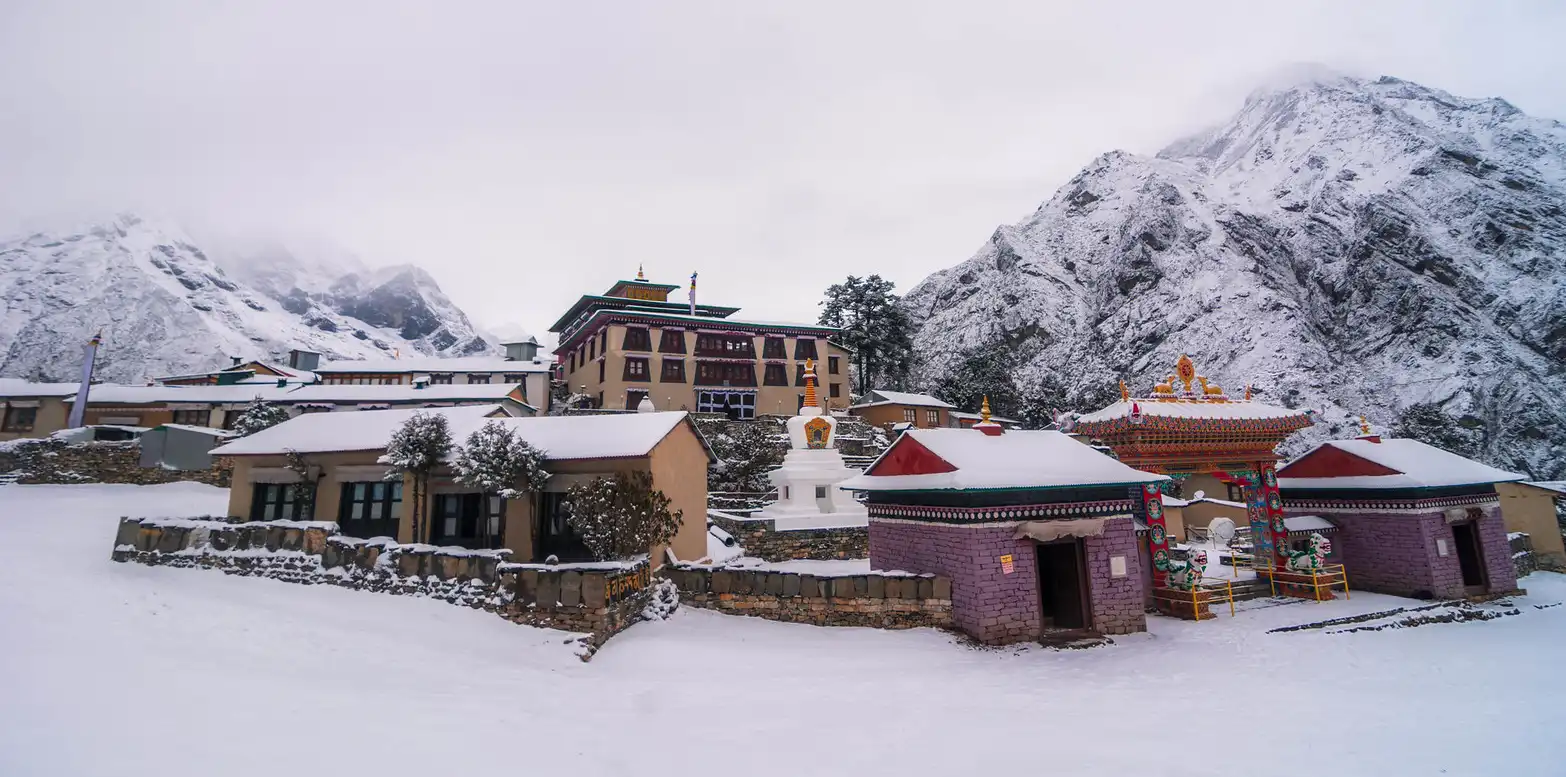
Celebrations like Mani Rimdu infuse color and context, inviting visitors to engage with and celebrate the Sherpas’ deep-rooted Buddhist practices. The unparalleled natural beauty of the region presents trekkers with some of the planet’s most stunning mountain vistas, including the majestic Mt. Everest. Adventurers traversing this terrain encounter diverse flora and fauna adapted to the high-altitude conditions, including rhododendron forests and rare species like the snow leopard and red panda.
This biodiversity not only adds wonder to the trek but also highlights the need for conservation in these fragile ecosystems. The Everest Region also caters to a broad range of trekking skills, making it a perfect destination for both beginners and experienced mountaineers. Each group finds trails that test their skills and reward them with breathtaking views and personal triumphs. Top 5 Treks in Everest Region are listed below:
1. Everest Base Camp Trek
Everest Base Camp Trekking ranks among the most renowned trails in the world. As trekkers travel in the shadow of the highest peak on Earth, they experience a breathtaking adventure. The trek begins with a thrilling flight from Kathmandu to Lukla, introducing trekkers to the excitement of landing at the world’s most adventurous airport in Lukla. The arrival stirs an extraordinary feeling of thrill and joy, and I am ready to start the trek.
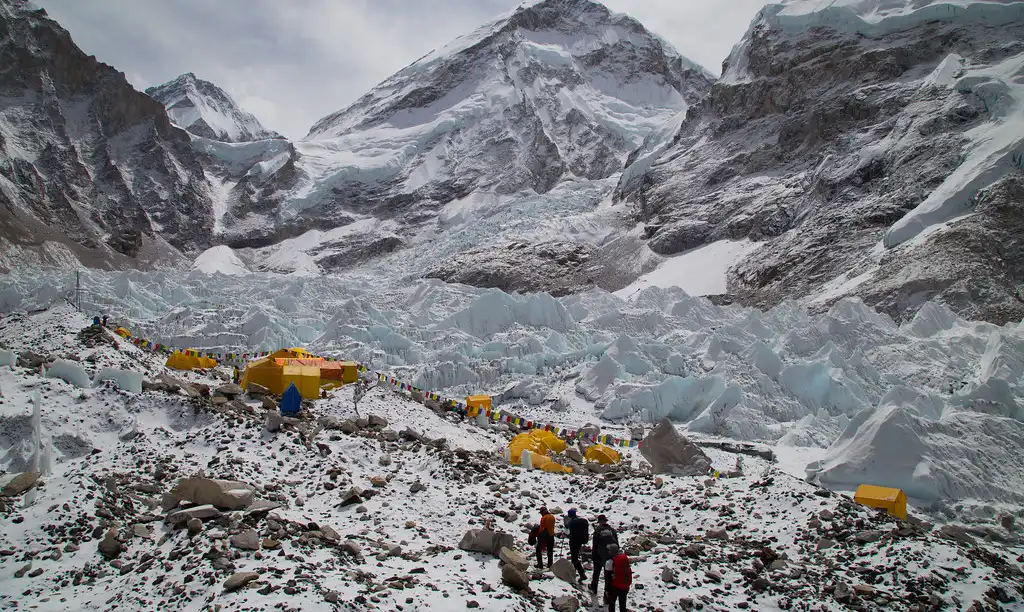
Nepal offers a variety of treks to suit anyone, based on duration and purpose. Among these, the Everest Base Camp trek stands out as one of the top trekking destinations globally, offering life-changing and spectacular Himalayan vistas. The South base camp in Nepal and the Everest Advance Base Camp North in Tibet serve as the primary starting points for treks to the summit of the highest mountain on Earth.
As a famous saying goes, Your attitude, not your aptitude, will determine your altitude. The desire to reach the summit draws people to high altitudes. The South Everest Base Camp sits at an altitude of 5380 meters (17,600 feet). With fitness and strong determination, reaching this altitude is achievable for those set on reaching their goal.
Key Attractions of the Everest Base Camp Trek
Kala Patthar: Regarded as the Everest Base Camp Trek’s prime highlight, Kala Patthar offers trekkers the closest accessible view of Mount Everest. Sitting at an elevation of 5,644 meters (18,519 feet), it presents panoramic views that encompass Everest, Nuptse, Changtse, and the whole southern face of Lhotse.
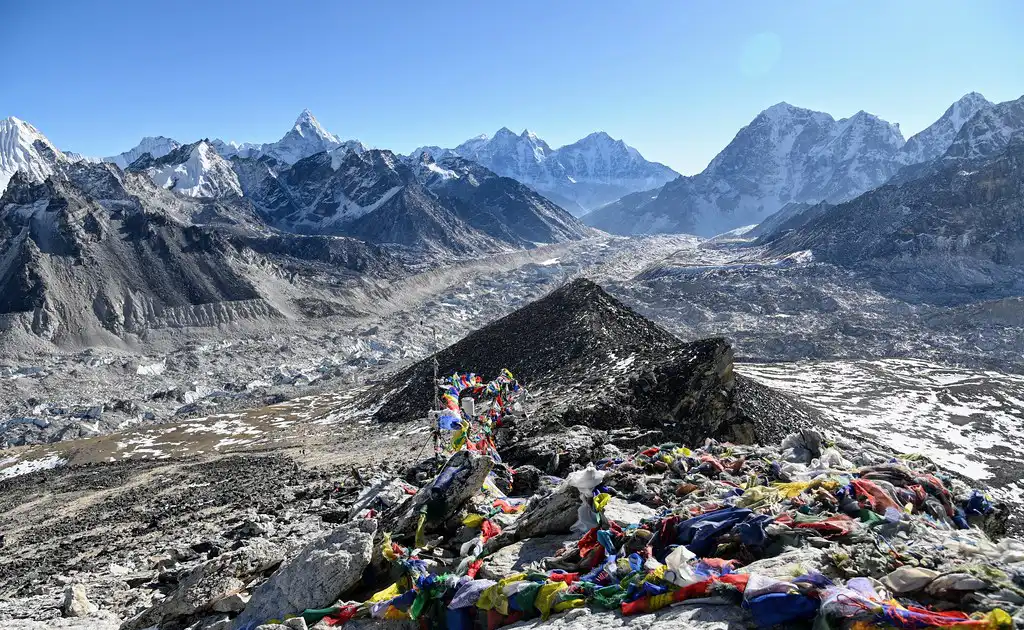
Trekkers typically ascend Kala Patthar early in the morning to capture the stunning sunrise illuminating the Himalayan peaks, an unforgettable spectacle as the sunlight glimmers across these towering mountains.
Tengboche Monastery: At an altitude of 3,867 meters (12,687 feet), Tengboche Monastery stands as a key stop on the Everest Base Camp route.
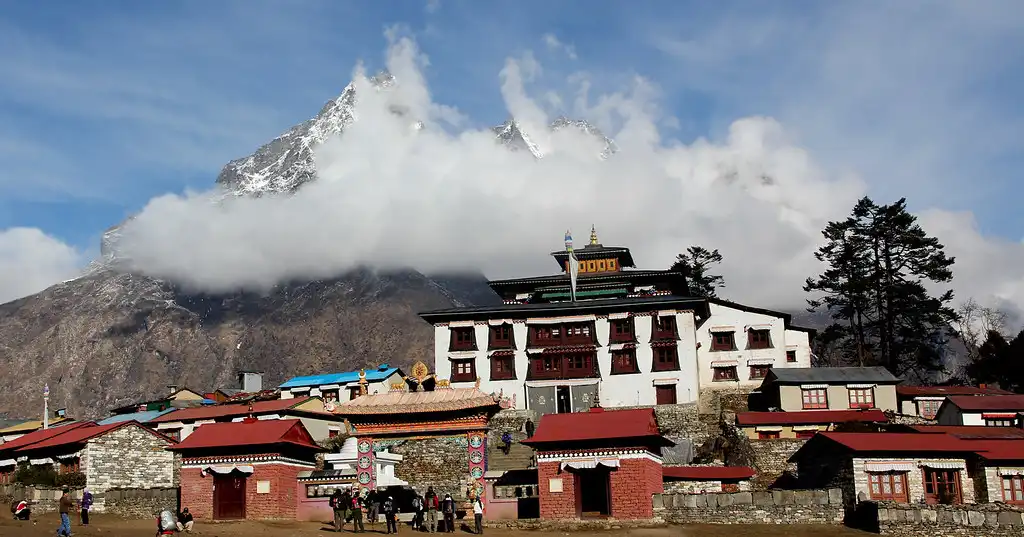
It is the largest gompa in the Khumbu region, celebrated not only for its deep religious importance but also for its breathtaking views of Everest, Ama Dablam, and Thamserku. During October and November, the monastery becomes the vibrant heart of the Mani Rimdu festival, offering trekkers a profound glimpse into the Sherpas’ spiritual customs.
Best Time for Everest Base Camp Trek
Spring (March to May)
The spring months from March to May are the peak season for trekking to Everest Base Camp, known for its stable and warm weather. Clear skies ensure excellent visibility, which is crucial for both trekking and climbing. During this period, trekkers enjoy paths lined with lush, blooming rhododendrons, enhancing the scenic beauty.
Adventurers and mountaineers from around the world fill the trekking paths with energy each spring. This season offers more than climbs to higher altitudes; it’s also a time to delve into the vibrant cultural life at teahouses and lodges. The possibility of summiting Everest attracts many, creating a bustling, communal atmosphere on the paths. Trekkers from various backgrounds share stories and experiences, adding a rich, interpersonal element to the adventure.
Spring draws the most trekkers and climbers, with numbers ranging between 30,000 and 35,000 visitors to the Everest Region. This surge of visitors energizes the trail but also strains facilities like lodges and teahouses, emphasizing the need for bookings.
Although the weather is generally safe and stable in spring, it can change unpredictably in the Everest Region. Sudden snowfalls and cold snaps, particularly at higher altitudes, can make the trails slippery and obscure the paths. Avalanches and landslides, though less common in spring, still pose potential risks.
Helicopter services become crucial during this peak season, providing necessary emergency rescues and evacuations. These services handle health-related emergencies such as altitude sickness and injuries and respond to climbers and trekkers affected by sudden weather changes. With more trekkers and complex expeditions, the demand for helicopter services increases, ensuring critical support is always available.
Autumn (September to November)
Autumn, spanning September to November, presents an excellent trekking season at Everest Base Camp. Clear skies and mild climate dominate these months, setting ideal hiking conditions. Monsoon rains clear the air beforehand, leaving it crisp and free from pollution, which enhances the visual experience. Cooler temperatures make the physical demands of the hike more manageable.
The clarity of the Himalayan panorama reaches its peak in autumn, offering what many consider the most breathtaking views of the mountain range. Such high visibility allows trekkers to observe the fine details of distant peaks, contributing to an awe-inspiring experience in one of the world’s highest locales.
A significant number of trekkers, typically between 25,000 and 30,000, visit the Everest Region during these months. The season’s reliability and excellent conditions make it popular, resulting in well-trodden paths and fully operational facilities such as teahouses and lodges. Because of this, booking accommodations in advance is not good enough.
Although autumn is known for stable weather, the Everest Region can still face sudden weather shifts that pose risks. Short-lived snowstorms and sudden temperature drops can occur, especially at higher altitudes, leading to slippery trails and obscured paths, which increase the risk of accidents.
Helicopter services prove essential during the autumn season, serving as a critical safety net for emergencies. They swiftly evacuate trekkers facing health issues like altitude sickness or injuries and are on standby for severe weather conditions that might endanger trekkers. The high demand for these services ensures their readiness to respond to emergencies promptly, providing essential help whenever needed.
Essential Tips for Trekkers
Acclimatization: When trekking at high altitudes like those in the Everest Region, acclimatizing becomes essential. To prevent altitude sickness, trekkers must allow their bodies to adapt to the lower oxygen levels. Itineraries should incorporate specific acclimatization days, usually involving staying at the same altitude for a minimum of two nights after ascending every 600-900 meters. Namche Bazaar and Dingboche are popular stops for these crucial rest days, where light activities can aid effective adaptation.
Permits: Trekkers must secure several permits to explore the Everest Region: the Sagarmatha National Park Permit and the Khumbu Pasang Lhamu Rural Municipality Permit. At the same time, a TIMS card is optional for the Everest Base Camp Trek. These permits are available in Kathmandu or at checkpoints along the trekking route. Trekkers should keep these permits handy and secure, as officials frequently check them.
Local Customs: Honoring local customs is vital. The Sherpa community, which deeply values its religious practices, populates this region. Trekkers need to dress modestly, avoid public displays of affection, and always seek permission before photographing people or sacred sites. Additionally, it is respectful to circle mani stones and prayer wheels clockwise.
Gokyo Cho La Pass Trek
Everest High Pass Trek
Everest Base Camp Trek for Beginners
2. Gokyo Cho La Pass Trek
The Gokyo Cho La Pass Trek offers abundant opportunities to experience the vast Himalayan range. This trek in the Everest region showcases glacial lakes, the culture of the Sherpa community, glacial rivers, and alpine forests. Additionally, the Gokyo Cho La Pass Trek includes paths ideal for peak climbing enthusiasts. For those seeking high-altitude adventures and wild, snowy landscapes featuring glacial rivers and lakes, the Gokyo Ri Trek stands out as the perfect destination.
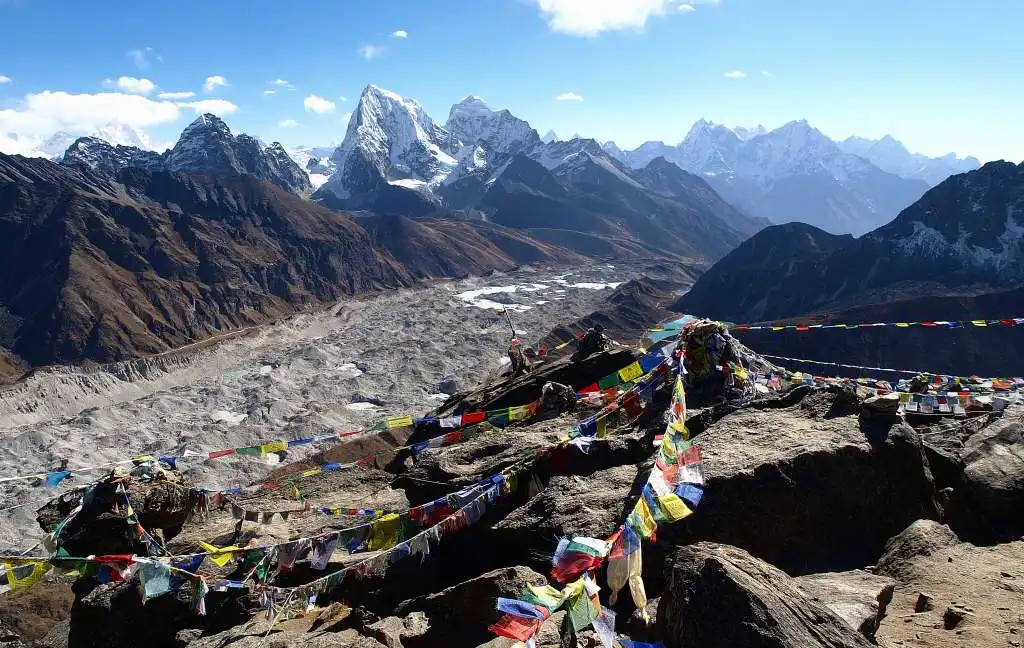
Nepal, home to eight of the world’s ten highest peaks, serves as a prime location for stunning mountain views. The Sagarmatha National Park adds to the allure with its rich biodiversity, captivating both flora and fauna enthusiasts. The trek along the Gokyo Cho La Pass route offers more than just scenic heights; it provides a deep dive into the welcoming culture of Sherpa villagers, their monastic practices, diverse cultural traditions, scenic beauty, and the celebration of various gods, enriching the trekking experience.
Route and Major Highlights
Gokyo Ri: As a significant highlight of the Gokyo Cho La Pass Trek, Gokyo Ri towers at 5,357 meters (17,575 feet), providing trekkers with sweeping panoramic views of the Himalayan range, including Mount Everest, Lhotse, Makalu, and Cho Oyu. Trekkers typically tackle the challenging ascent to Gokyo Ri early in the morning to witness the breathtaking sunrise that bathes the snowy peaks in golden light.
Gokyo Lakes: Situated between 4,700 and 5,000 meters, the Gokyo Lakes comprise six stunning glacial lakes, ranking among the highest freshwater bodies in the world.
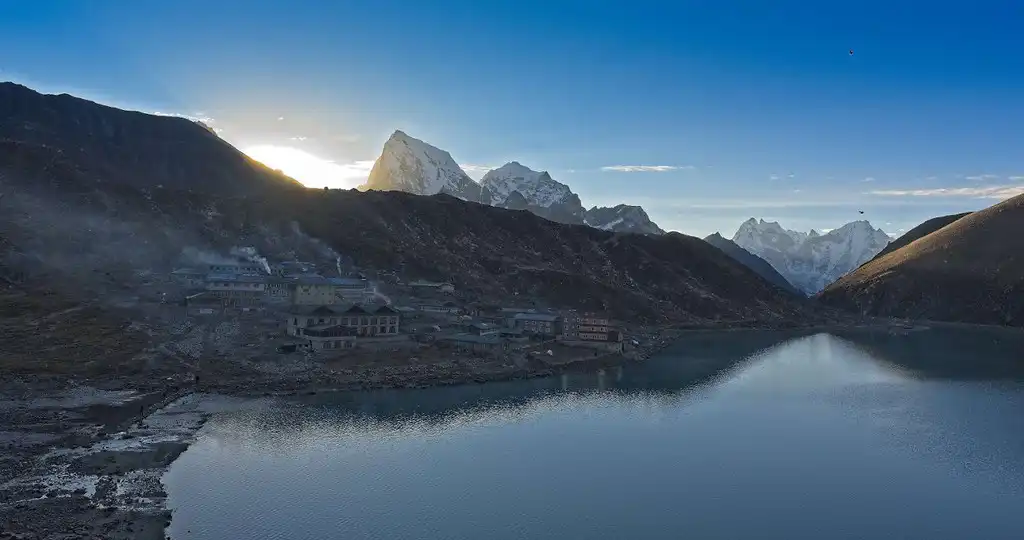
Sacred to Hindus and Buddhists, these turquoise lakes offer tranquil and picturesque rest spots during the trek, with Thonak Lake being the largest and most popular point for trekkers to pause and take in the scenery.
Cho La Pass: At 5,420 meters (17,782 feet), Cho La Pass forms a critical connection between the Gokyo and Khumbu Valleys, offering a challenging yet rewarding crossing. The pass includes a glacier crossing that may be icy and demands careful navigation. The views from the past are spectacular, featuring glaciers, towering peaks, and rugged landscapes.
Trekking Challenges and How to Prepare
Challenges
Regarded as challenging, the Gokyo Cho La Pass Trek presents obstacles such as high altitudes, steep ascents, and rugged terrains. The weather can further complicate the trek, especially at Gokyo Ri and Cho La Pass, where temperatures often plummet, and snowfall may block pathways.
Preparation
Physical Fitness: Trekkers should undertake extensive cardiovascular training like hiking, cycling, swimming, or running well ahead of their trek to build endurance and stamina.
Gear: Necessary gear includes durable hiking boots, thermal wear, a down jacket, a cold-rated sleeping bag, and trekking poles. To navigate Cho La Pass, crampons and an ice axe are recommended.
Acclimatization: It is vital to include acclimatization days in your trek plan to prevent altitude sickness. This strategy involves staying at moderate elevations and advancing slowly over several days.
Guides and Porters: Employing knowledgeable guides and porters can enhance safety and reduce the physical strain of carrying equipment. Guides also offer valuable cultural and natural insights.
Travel Insurance: Securing travel insurance that covers high-altitude trekking and potential emergency helicopter rescues is crucial due to the remote and elevated nature of the trek.
Recommended Gear and Preparation Tips
Gear Essentials
Successfully trekking through the Gokyo Cho La Pass requires the right equipment. Your packing list should include:
Hiking Boots: Opt for boots that are well-fitted, durable, and already broken in to avoid blisters and ensure support.
Layered Clothing: Bring along thermal base layers, a fleece jacket, and outer layers that are both waterproof and windproof to adapt to changing mountain weather.
Sleeping Bag: Invest in a high-quality sleeping bag designed for sub-zero temperatures, which is crucial for staying warm during high-altitude nights.
Trekking Poles: These help reduce knee strain on descents and add stability.
Sunglasses and Sunscreen: Protect yourself from intense UV rays at high altitudes with sunglasses and sunscreen with a high SPF.
Navigation Tools: Carry maps and a compass, and consider a GPS device for guidance, even if accompanied by a guide.
First Aid Kit: Pack a kit with altitude sickness medication, pain relievers, bandages, and any personal medications.
Preparation Tips
Fitness Training: Engage in consistent cardio activities like running, swimming, or cycling. Additionally, strengthen your legs by hiking or stair climbing.
Mental Preparation: Learn about the trek’s challenges by researching or speaking with experienced trekkers.
Diet and Hydration: Increase your fluid intake and consume a diet rich in carbohydrates and proteins before and during the trek.
Acclimatization: Spend a few days at high altitudes before starting the trek to help your body adjust.
3. Luxury Everest Base Camp Trek
The Luxury Everest Base Camp Trek offered by Peregrine Treks and Tours presents a unique and unforgettable trek. This exceptional trek starts in Lukla, leads to Everest Base Camp, and concludes with a helicopter ride from Gorakshep back to Kathmandu, ensuring a delightful and comfortable experience. The term Luxury truly applies here as the accommodations from the start to the end of the trek are outstanding and full of amenities.
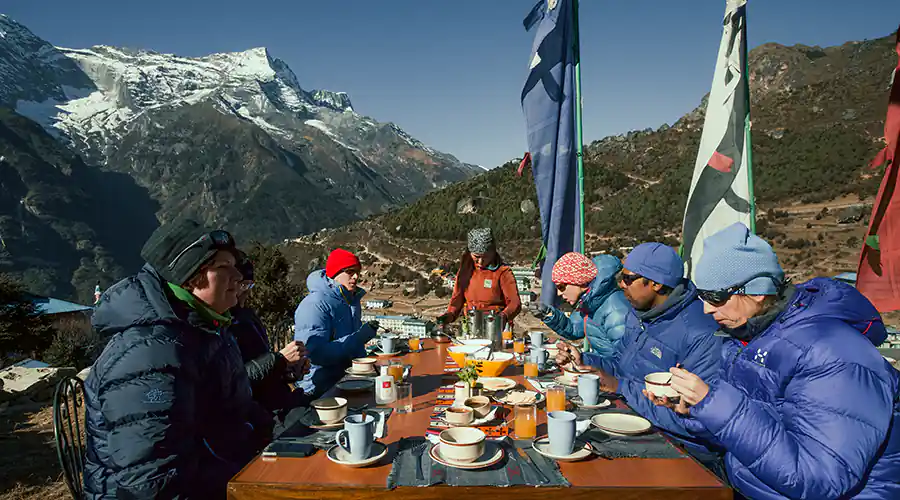
This luxury trek invites you to experience the immense charm of the Eastern Himalayan region of Nepal. From the icy expanse of Imja to the Lhotse glaciers, every view within the Everest region will captivate and amaze you to the fullest.
Furthermore, a helicopter ride from Gorakshep to Lukla offers a thrilling experience, providing a clear view of mountains such as Ama Dablam, Everest, Lhotse, Cho Oyu, and Makalu. Throughout the trek, you’ll also encounter the rich Himalayan flora and diverse species within the Sagarmatha National Park. The trek is enhanced by rhododendron forests and seasonal flowers, adding an extra layer of allure to the Luxury Everest Base Camp Trek.
Comparison with the Standard Everest Base Camp Trek
Accommodation: Standard Everest Base Camp (EBC) treks typically use basic teahouses or lodges, offering minimal services like shared rooms, communal bathrooms, and limited heating. In contrast, the Luxury Everest Base Camp Trek features the trail’s highest quality lodges, which provide private rooms, en-suite bathrooms, comfortable bedding, and sometimes amenities such as heated rooms and hot showers.
Services: The standard EBC trek provides essential services with meals that are hearty yet limited to local cuisines. The Luxury Trek enhances the experience by offering a greater variety of meal options, including Western dishes prepared to high standards. Additional amenities include daily room cleaning, Wi-Fi, and spa facilities at certain lodges.
Cost: The Luxury Everest Base Camp Trek costs considerably more than the standard trek, reflecting its superior accommodations, enhanced services, and extra comforts such as helicopter returns, which are not typically part of the standard package.
Exclusive Experiences
The Luxury Everest Base Camp Trek includes several exclusive experiences not usually found on the standard trek:
Helicopter Ride: The trek features a scenic helicopter flight from Gorakshep to Kathmandu, showcasing breathtaking aerial views of the Everest region, which other trekkers rarely see.
Cultural Immersion: The trek offers enhanced opportunities for cultural interaction, including comprehensive visits to monasteries and villages where expert guides share insights into local history and traditions.
Personalized Service: With fewer trekkers per guide, private transfers, and often personal porters, the level of personal attention is much higher on the luxury trek.
Wellness Opportunities: Some luxury packages offer wellness options like massages or yoga sessions to help trekkers unwind after long days on the trail.
Advice on Choosing the Right Tour Operator for Luxury Treks
Reputation and Reviews: Begin by investigating the reputation of potential tour operators. Seek out client reviews and testimonials on travel forums, social media, and their websites. High ratings and positive feedback typically suggest that the operator is reliable and provides quality service.
Experience and Expertise: Select operators with a solid background in managing luxury treks. These operators should possess in-depth knowledge of the region and understand the unique challenges of high-altitude trekking. Local guides with extensive experience can greatly enrich your trekking experience by offering personal insights into the local culture and landscape.
Safety Measures and Support: Confirm that the operator has strong safety protocols and emergency support systems in place, which are crucial for high-altitude treks where health concerns are more likely to arise. Access to guides trained in first aid and emergency procedures, who can facilitate emergency evacuations if necessary, should be included.
Customization Options: Look for luxury tour operators who provide customizable trekking itineraries tailored to meet your interests and physical conditions. They should be willing to modify the trek’s schedule, accommodations, and services to better suit your needs.
Sustainability Commitments: Operators who commit to environmental and cultural sustainability are preferred. They should engage in practices that reduce environmental impacts and support the local communities.
Highlight on Sustainable Luxury Trekking Practices
Minimizing Environmental Impact: Luxury treks should aim to be eco-friendly. Operators need to adopt practices like utilizing solar power when possible, efficiently managing waste by removing it from remote areas, and opting for biodegradable products.
Supporting Local Communities: Ensure your choice of operators hires local staff and guides, pays fair wages, and contributes to community projects. This approach not only boosts the local economy but also enriches your trekking experience with genuine cultural interactions.
Cultural Respect and Preservation: Maintaining respect for and helping to preserve local cultures is crucial. Operators should educate trekkers about local customs and traditions, promote respectful interactions, and contribute to the maintenance of historical and cultural sites.
Wildlife Conservation: Operators must ensure that their treks do not interfere with local wildlife. It involves maintaining a respectful distance from animals, refraining from feeding wildlife, and avoiding any actions that could damage their habitats.
Island Peak Climbing with EBC Trek
Jiri to Everest Base Camp Trek
4. Island Peak Climbing with EBC Trek
The government of Nepal has granted climbing permits for 33 peaks, among which Island Peak, also known as Imja Tse, stands out as the most popular and visually stunning. Climbers can attempt the ascent in any season, thanks to its year-round accessibility.
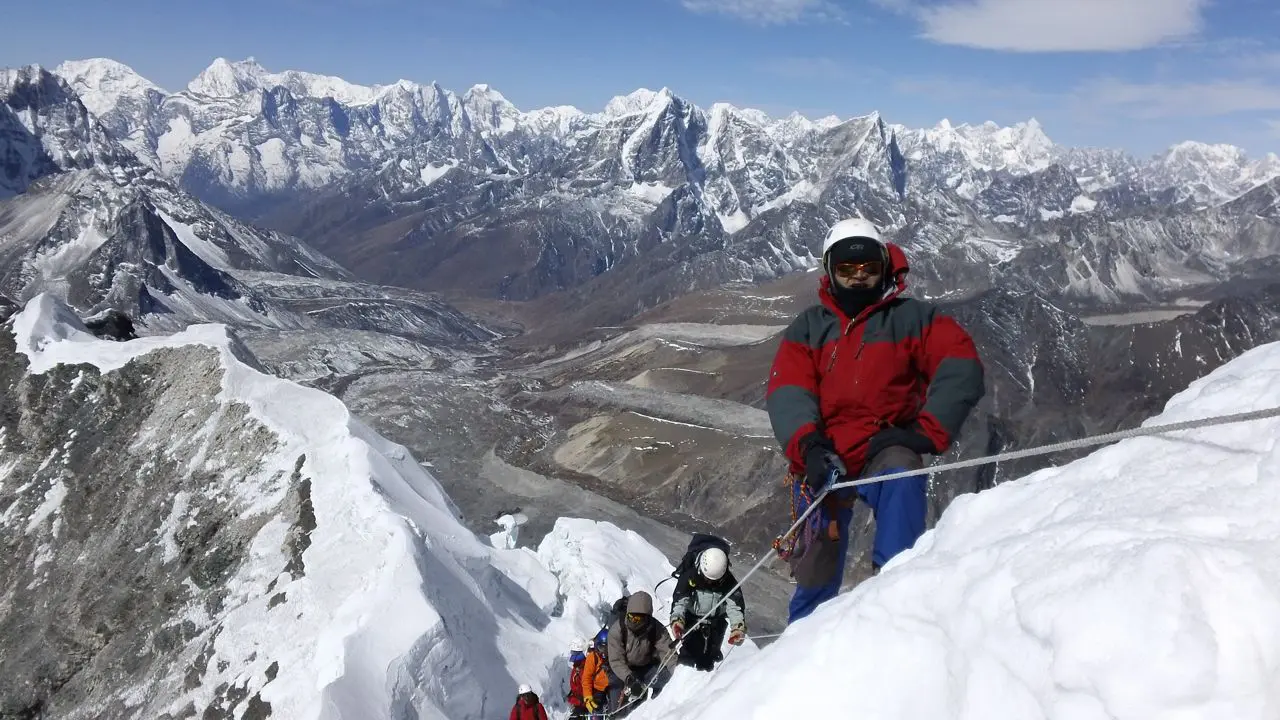
A British expedition first conquered Island Peak in 1953, marking the beginning of its popularity among climbers. One of the key reasons many choose to climb Island Peak is its role as an acclimatization climb, preparing them for higher peaks. The trek to Island Peak begins at its base camp and includes the Everest Base Camp (EBC) Trek, offering a comprehensive experience of both trekking and peak climbing.
The Peregrine Treks team guides climbers through the EBC and Island Peak trails, passing through scenic locations such as Namche Bazaar, Lukla, Tengboche, and Phakding. Climbing this peak not only provides a thrilling adventure but also offers breathtaking views of the Khumbu region’s landmarks. One might liken the peak’s position to an island amidst a glacial sea.
Surrounding the peak, a semicircle of cliffs rises to the north, culminating in the summit of Nuptse, Lhotse Middle Peak, and Lhotse. To the east, the landscape ascends above the icy expanse of the Lhotse Glacier and Cho pole, with the red granite mass of Makalu (8475m/ 27805ft) visible in the distance. To the south, the Imja and Baruntse peaks lead to the stunning Ama Dablam, resembling a giant sentinel in a vast sea.
Combined Trek and Climb Route
The Island Peak Climbing with Everest Base Camp Trek combines the iconic EBC trek with an ascent of Island Peak, also known as Imja Tse. This adventurous trek weaves through the famed trails of the Khumbu region and culminates in the challenging summit of Island Peak.
Trekking Route
The adventure kicks off with a flight from Kathmandu to Lukla’s mountain airstrip, the trek’s starting point. Trekkers then move on to Namche Bazaar, the gateway to Everest and a crucial spot for acclimatization. The path continues through Tengboche, with its renowned monastery, and Dingboche, another key acclimatization site, leading up to Everest Base Camp. After exploring Base Camp and the panoramic vistas at Kala Patthar, the route circles back to Dingboche and advances to Chhukung, the last stop before Island Peak Base Camp.
Climbing Route
Climbers start from Island Peak Base Camp and tackle the ascent of the 6,189-meter peak. The climb, beginning early in the morning, involves a same-day ascent and descent. The path crosses a glacier and involves navigating crevasses with ladders, climbing a steep snow and ice headwall, and traversing a narrow summit ridge that offers stunning views of the surrounding Himalayan peaks.
Physical and Technical Requirements for Climbers
Physical Fitness: The physical demands of climbing Island Peak are considerable, requiring robust cardiovascular fitness, strength, and endurance. Prospective climbers should undertake extensive physical training for months beforehand, incorporating cardio exercises, strength training, and long hikes.
Technical Skills: Although Island Peak is accessible for mountaineering beginners, it still demands basic technical climbing abilities. Climbers need familiarity with using ice axes, crampons, and harnesses. They must know how to safely manage ropes and other climbing equipment, particularly when crossing crevasses and scaling the final headwall.
Acclimatization: Effective acclimatization is essential to prevent altitude sickness. The trek is designed with multiple elevation stops, including significant acclimatization points at Namche Bazaar and Dingboche, to help the body adjust to the high altitude.
Guidance and Support: Undertaking this climb under the supervision of experienced climbing guides is highly recommended. They provide vital support and ensure adherence to safety protocols, including strategies for emergency response.
Equipment and Guide Information
Essential Equipment
Climbers tackling Island Peak must equip themselves with specific gear tailored to the unique demands of high-altitude and glacier travel. Essential items include:
Climbing Harness: Vital for secure roped travel on steep or icy sections.
Ice Axe: Critical for maintaining stability on snow and ice.
Crampons: Necessary for traction on icy surfaces and crucial for ascending the headwall.
Mountaineering Boots: These should be stiff-soled and crampon-compatible for effective climbing.
Helmet: Offers protection from falling debris and during falls.
Rope: Essential for securing climbers across crevasses during the ascent.
Ascenders and Descenders: These are useful for efficient rope management, especially on steep or technical climbs.
Carabiners, Slings, and Pulleys: Crucial for creating safety systems and navigating complex terrain.
Guide Expertise
Hiring experienced guides is crucial for a successful Island Peak climb. Guides must be:
Well-trained in Mountaineering: They should hold certifications and have a solid track record in high-altitude climbing.
Experienced with Island Peak: They must know the route’s specific challenges and conditions.
First Aid Certified: They should be capable of managing medical emergencies and treating altitude sickness.
Skilled in Navigation and Weather Forecasting: They need to make informed decisions based on changing conditions.
Safety Measures and Best Practices for a Successful Climb
Physical Fitness: Climbers should engage in a thorough training regimen to build endurance, strength, and altitude readiness.
Technical Training: Practice is necessary with climbing equipment and techniques, particularly for glacier travel, crevasse navigation, and ice climbing.
Acclimatization: Implement a structured acclimatization plan to adjust to high altitudes, which includes spending several days at intermediate heights.
During the Climb
Weather Awareness: Constantly monitor the weather forecasts and conditions. The ability to adjust plans quickly is crucial at high altitudes.
Communication: Keep in regular touch with your team and local support using radios or satellite phones.
Stay Hydrated and Nourished: Continuously hydrate and eat high-energy foods, as physical exertion and altitude quickly deplete body resources.
Emergency Protocols
Recognize Symptoms of Altitude Sickness: Watch for early signs of altitude sickness, such as headaches, nausea, dizziness, and fatigue, and address them promptly.
Carry a First Aid Kit: Your team should have a comprehensive first aid kit ready, with treatments for common ailments and injuries.
Plan for Evacuation: Establish and practice a clear evacuation strategy for severe illness or injury, which might include helicopter evacuation if necessary.
5. Other Alternative Trekking in the Everest Region
Everest High Pass Trek
Designed for experienced trekkers, the Everest High Pass Trek challenges participants with the crossing of three high-altitude passes: Kongma La (5,535m), Cho La (5,420m), and Renjo La (5,446m). This trek ranks among the most demanding in the Everest region.
Highlights
Remote Valleys and High-Altitude Lakes: Participants trek through secluded and untouched landscapes, enjoying serene beauty and tranquility away from busier routes.
Sherpa Villages: The trek routes through authentic Sherpa villages offer deep dives into the vibrant culture and daily life of the Himalayan inhabitants.
Mountain Passes: Each pass offers its unique set of challenges and bestows trekkers with awe-inspiring panoramic views of the Himalayan giants like Everest, Lhotse, and Makalu.
Duration and Fitness Level
Duration: Ranges from 17-20 days, influenced by weather conditions and acclimatization rates.
Fitness Level: Demands superior physical condition due to lengthy days of trekking through steep, rocky, and occasionally snowy terrains. We strongly recommend having experience in high-altitude trekking.
Everest View Trek
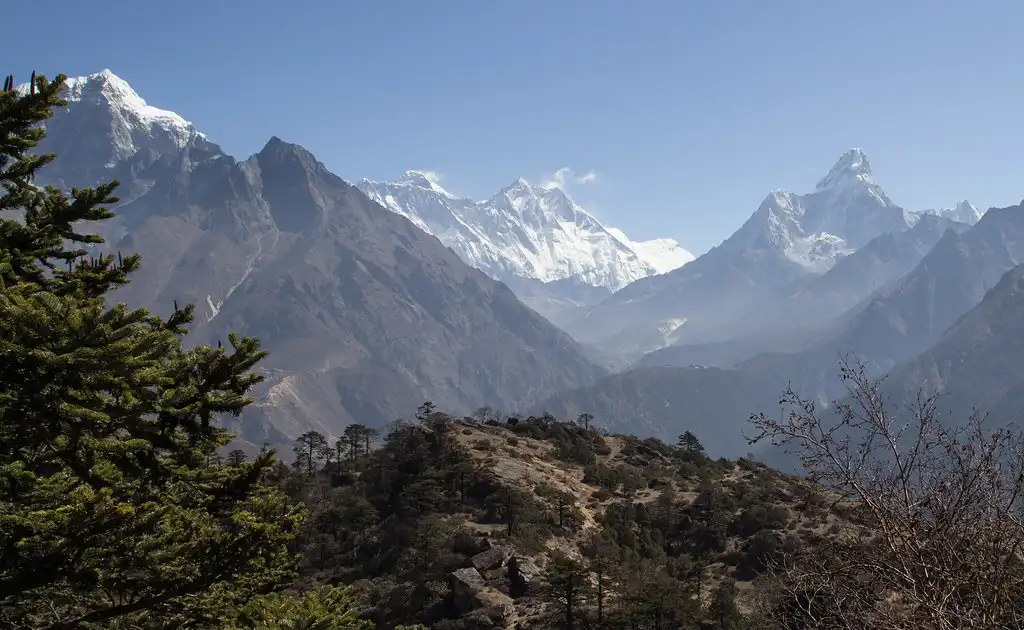
The Everest View Trek caters to those seeking a less demanding experience but still desiring magnificent views of Mount Everest and surrounding peaks. It’s perfect for those with limited time or new to high-altitude trekking.
Highlights
Panoramic Views: Features several exceptional viewpoints, such as Tengboche and Namche Bazaar, showcasing the stunning vistas of Everest and Ama Dablam.
Cultural Experience: Includes visits to prominent monasteries and interactions with the Sherpa community, enriching trekkers with cultural insights.
Accessibility: This trek welcomes a wide range of trekkers, including those less experienced in high-altitude conditions.
Duration and Fitness Level
Duration: Typically completed within 7-10 days.
Fitness Level: Requires moderate fitness, involving some uphill walking but at a less intense pace than longer treks.
Everest Base Camp Trek with Helicopter Return
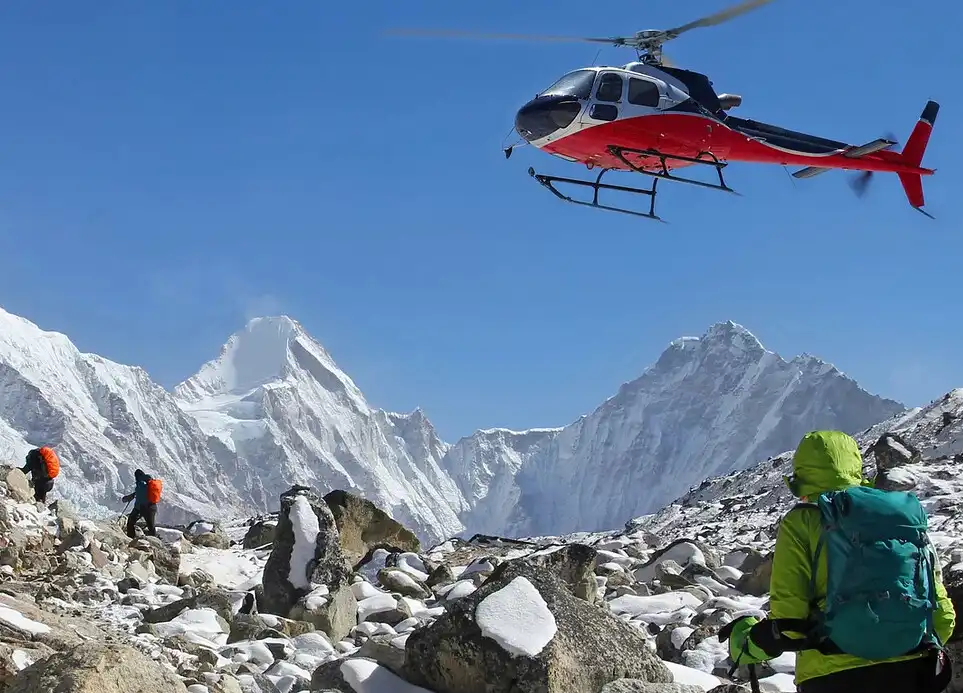
This trek combines the iconic Everest Base Camp trek with the speed and excitement of a helicopter return from Gorakshep to Kathmandu, reducing travel time significantly.
Highlights
Everest Base Camp: Offers the exhilarating experience of reaching the base of the highest mountain in the world, with up-close views of the Khumbu Icefall.
Helicopter Return: Treats trekkers to a spectacular aerial view of the landscapes traversed, adding a unique dimension to the trek.
Reduced Duration: The helicopter considerably shortens the return period, appealing to those with tight schedules.
Duration and Fitness Level
Duration: Usually spans 10-12 days, helicopter return included.
Fitness Level: Requires moderate to high fitness, as the trek involves substantial physical effort up to Base Camp. The helicopter alleviates the strain of the return trek.
How to Choose the Right Trek
When deciding on a trek, consider your physical fitness, trekking history, available time, and personal interests. Whether you seek severe high-altitude challenges, aim to immerse yourself in local culture, or desire to enjoy spectacular views with some comfort, these treks provide varied experiences to match different preferences. Each trek provides a distinct way to witness the grandeur of the Everest region, tailored to diverse adventure levels and exploration desires.
Conclusion
The Everest Region presents various trekking options, each with its own set of unique challenges and experiences. The challenging Everest High Pass Trek, the more accessible Everest View Trek, and the luxurious Everest Base Camp Trek with a helicopter return each cater to different fitness levels and adventurer preferences.
Preparing thoroughly and respecting the local culture and environment are essential as you plan your trek. Responsible and sustainable exploration helps ensure both the safety and enjoyment of trekkers and aids in preserving the natural and cultural heritage of this magnificent region for future generations.

